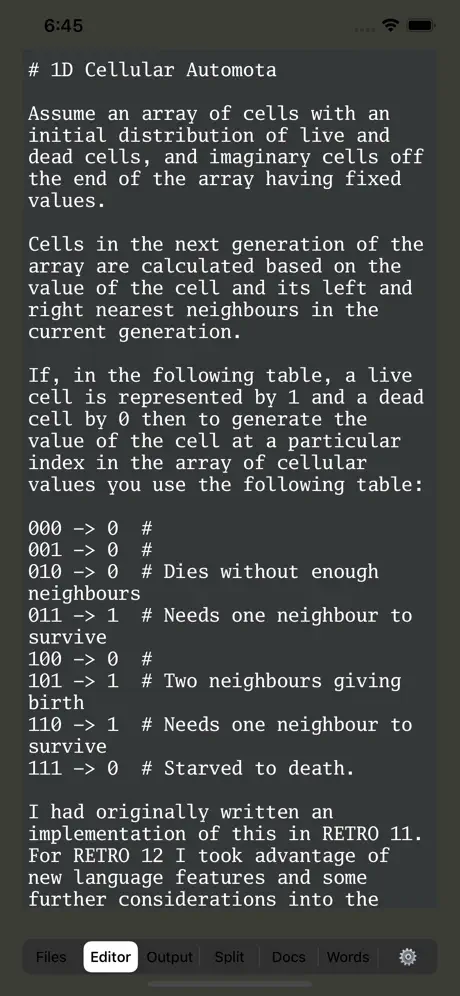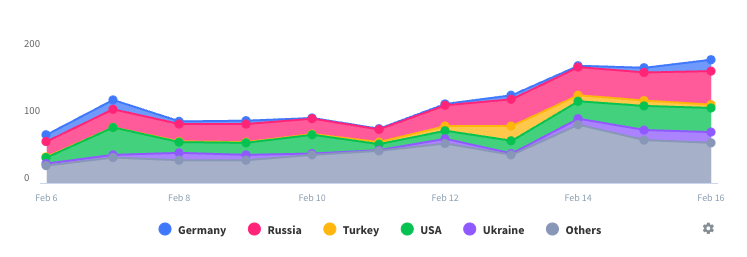
Description
RETRO FORTH is a concatenative programming language with roots in Forth. Designed to be compact, learnable, and easy to adapt to specific needs, it has been developed and refined through continual use by a small community over more than a decade.
Forth is a stack based programming language created in the late 1960's by Chuck Moore. Over the intervening decades it has evolved through use, with many dialects along the way.
The Retro dialect was created in the late 1990's, and has been continually developed and supported for over 15 years. It is a structured, imperative stack-based language with modern facilities including quotations and reflection.
It features:
- latest version of the RETRO language
- a code editor using Markdown subset
- literate programming style
- code is extracted from fenced blocks in Markdown source allowing easy mixing of code and commentary
- allows use of unicode & emoji in source & commentary
- interactive listener interface for quick interactions
- simple console output and text input
- editor provides quick access to numbers and symbols
- support for fetching textual data from Gopher servers
- file manager
- documentation browser
It also includes documentation and several optional examples.
Hide
Show More...
Forth is a stack based programming language created in the late 1960's by Chuck Moore. Over the intervening decades it has evolved through use, with many dialects along the way.
The Retro dialect was created in the late 1990's, and has been continually developed and supported for over 15 years. It is a structured, imperative stack-based language with modern facilities including quotations and reflection.
It features:
- latest version of the RETRO language
- a code editor using Markdown subset
- literate programming style
- code is extracted from fenced blocks in Markdown source allowing easy mixing of code and commentary
- allows use of unicode & emoji in source & commentary
- interactive listener interface for quick interactions
- simple console output and text input
- editor provides quick access to numbers and symbols
- support for fetching textual data from Gopher servers
- file manager
- documentation browser
It also includes documentation and several optional examples.
Screenshots
RETRO FORTH FAQ
-
Is RETRO FORTH free?
Yes, RETRO FORTH is completely free and it doesn't have any in-app purchases or subscriptions.
-
Is RETRO FORTH legit?
Not enough reviews to make a reliable assessment. The app needs more user feedback.
Thanks for the vote -
How much does RETRO FORTH cost?
RETRO FORTH is free.
-
What is RETRO FORTH revenue?
To get estimated revenue of RETRO FORTH app and other AppStore insights you can sign up to AppTail Mobile Analytics Platform.

User Rating
3.5 out of 5
2 ratings in United Kingdom
5 star
0
4 star
1
3 star
1
2 star
0
1 star
0

Ratings History
RETRO FORTH Reviews
No Reviews in United Kingdom
App doesn't have any reviews in United Kingdom yet.
Store Rankings

Ranking History

Category Rankings
|
Chart
|
Category
|
Rank
|
|---|---|---|
|
Top Free
|

|
356
|
|
Top Free
|

|
464
|
|
Top Free
|

|
484
|
Keywords
RETRO FORTH Competitors
RETRO FORTH Installs
Last 30 daysRETRO FORTH Revenue
Last 30 daysRETRO FORTH Revenue and Downloads
Gain valuable insights into RETRO FORTH performance with our analytics.
Sign up now to access downloads, revenue, and more.
Sign up now to access downloads, revenue, and more.
App Info
- Category
- Developer Tools
- Publisher
- Charles Childers
- Languages
- English
- Recent release
- 2021.1 (4 years ago )
- Released on
- Nov 8, 2016 (9 years ago )
- Also available in
- United States , Russia , United Kingdom , Netherlands , Germany , Poland , Czechia , Taiwan , Armenia , Argentina , Austria , Azerbaijan , Belgium , Brunei , Switzerland , Chile , China , Denmark , Dominican Republic , Algeria , Ecuador , Estonia , Egypt , Spain , France , Greece , Hong Kong SAR China , India , Iceland , Italy , Sri Lanka , Mexico , Norway , New Zealand , Peru , Pakistan , Saudi Arabia , Singapore , Slovakia , Thailand , Vietnam , Australia , Sweden , Madagascar , Canada , Ukraine , South Africa , Türkiye , Brazil , Belarus , Colombia , Croatia , Indonesia , Israel , Japan , South Korea , Lebanon , Lithuania , Malaysia , Nigeria , Romania , Finland , Kuwait , Hungary , Portugal , Ireland , Kazakhstan , Luxembourg , Philippines , Slovenia , United Arab Emirates
- Last Updated
- 1 week ago
This page includes copyrighted content from third parties, shared solely for commentary and research in accordance with fair use under applicable copyright laws. All trademarks, including product, service, and company names or logos, remain the property of their respective owners. Their use here falls under nominative fair use as outlined by trademark laws and does not suggest any affiliation with or endorsement by the trademark holders.






